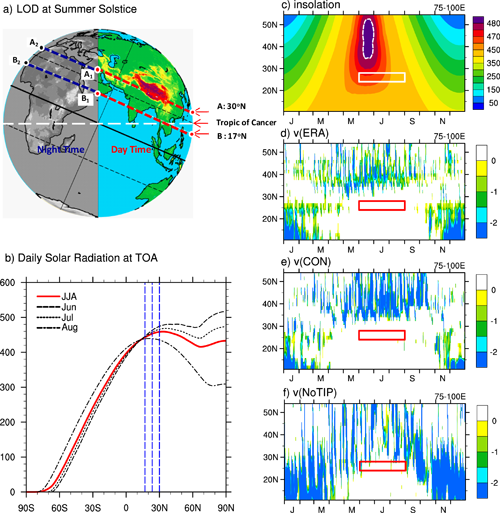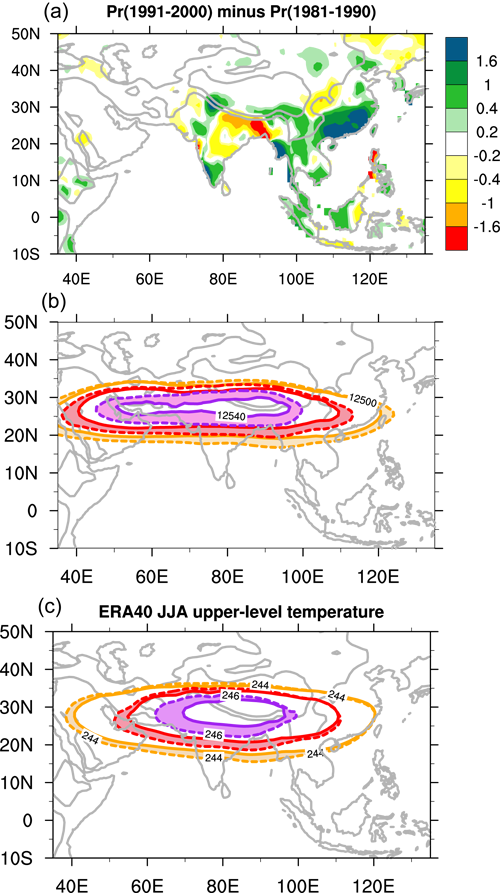How Do Tibetan-Iranian Plateaus Influence the Asian Summer Monsoon?
Date:2015-12-15
The influence of Tibetan Plateau (TP) on the Asian summer monsoon is a well-known scientific issue attracting many scientists. Understanding how the huge Tibetan and Iranian Plateaus affect the Asian summer monsoon is of great scientific value and has far reaching significance for sustainable global development.
Recently, Prof. WU Guoxiong and his colleagues from Institute of Atmospheric Physics, Chinese Academy of Sciences achieve some new research findings in this field. They revealed the physical processes on the role of TP on the occurrence of the moist convection and the formation of the Upper Troposphere Temperature Maximum (UTTM) over South Asia from the astronomical and hydrological perspective.

Fig. 1(a) Intensity of solar radiation (SR) and the length of day LOD at the TOA and at summer solstice; (b) latitude distributions of DSR in summer months; and annual evolution of (c) DSR (white-dashed denotes 480-contour), and of surface northerly occurrence along 75–100oE from (d) ERA-interim in 2001, (e) CON, and (f) NoTIP. The square in (c-f) indicates the SASM region (24–28oN)during JJA. Unit is (W m-2) in (b) and (c), and (m s-1) in d-f. The three dashed lines in (b) indicate the latitudes of 30oN, 23.5oN, and 17oN, respectively. (reprinted from He et al., 2015)
There has been a debate on the role of TP in affecting the formation of the South Asian summer monsoon (SASM). Prof. Wu’s team published a paper in 2012 which demonstrated that the formation of the Asian summer monsoon (ASM) is mainly controlled by the combined effects of the land-sea thermal contrast and topography heating, while the blocking effect of the TP is not the essential reason.
Based on astronomical radiation analysis and numerical modeling, the new research by the team shows that in winter the plateaus cannot block such a northerly intrusion; while in summer the daily solar radiation at the top of the atmosphere and at the surface, and the surface potential temperature to the north of the Tibetan Plateau, are higher than their counterparts to its south, and such plateau shielding is not needed (Fig .1). By virtue of hydrological analysis, they show that the high energy near the surface required for continental monsoon development is maintained mainly by high water vapor content. Results based on potential vorticity–potential temperature diagnosis further demonstrate that it is the pumping of water vapor from sea to land due to the thermal effects of the plateaus that breeds the Asian continental monsoon. This study has been recently published on Scientific Reports in 2015.

Fig. 2 Decadal changes in JJA mean climate between the periods (1991–2000) and (1981–1990) of (a) precipitation based on the PREC/L dataset (unit: mmd-1), (b) 200-hPa geopotential height (unit: gpm) and (c) the 200–400hPa mass-weighted temperature (unit: K) based on ERA40 reanalysis. The solid and dashed curves in (b) and (c) denote, respectively, the 1981–1990 and 1991–2000 means. (reprinted from Wu et al., 2015)
Additionally, the team made new interpretations on the formation of the UTTM over South Asian continent. They show that the latitude location of the UTTM coincides with the subtropical anticyclone, and its longitude location is determined by the zonal distribution of vertical gradient of heating/cooling (QZ), which is different from the Gill’s model. It is sensitive to convective heating: increased heating in the source region in a general circulation model causes intensification of both the SAH and UTTM, and imposing periodic convective heating there results in oscillations in the SAH, UTTM, and vertical motion to the west with the same period. Diagnoses of reanalysis indicate that such an inherent subtropical T-QZ relation is significant at interannual timescale. During the end of the twentieth century, rainfall increase over South China is accompanied by an increasing northerly flow aloft and intensification in the SAH and UTTM to the west (Fig .2). Results demonstrate that the feedback of atmospheric circulation to rainfall anomalies is an important contributor to the regional climate anomaly pattern. This study has been recently published on Climate Dynamics in 2015.
Reference:
1. He, B., G. X. Wu, Y. M. Liu, Q. Bao, 2015: Astronomical and Hydrological Perspective of Mountain Impacts on the Asian Summer Monsoon. Sci. Rep. 5:17586,DOI: 10.1038/srep17586. http://www.nature.com/articles/srep17586
2. Wu, G. X., B. He, Y. M. Liu, Q. Bao, and R. C. Ren, 2015: Location and variation of the summertime upper-troposphere temperature maximum over South Asia. Clim. Dyn, 45: 2757-2774. http://link.springer.com/article/10.1007/s00382-015-2506-4
3. Wu, Guoxiong, Yimin Liu, Bian He, Qing Bao, Anmin Duan &Fei-Fei Jin, 2012: Thermal Controls on theAsian Summer Monsoon. Sci. Rep. 2, 404; DOI:10.1038/srep00404. http://www.nature.com/articles/srep00404?message-global=remove&WT.ec_id=SREP-20120515
Contact:
HE Bian, heb@lasg.iap.ac.cn
